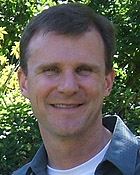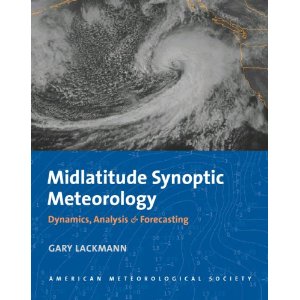Petterssen, Palmén and Newton, Carlson, and Lackmann
September 7, 2011 Filed under Blog, Featured, News, Resources, Uncategorized
I am honored to have seen page proofs of Gary Lackmann’s new book Midlatitude Synoptic Meteorology: Dynamics, Analysis, and Forecasting to be published later this year by the American Meteorological Society. For this book, Gary goes back to the original meaning of the word synoptic (“forming a summary or synopsis”). Twelve chapters summarize and synthesize all scales of motion, from the planetary down to the microphysical, not just those on the synoptic scale.
This is the first new book on synoptic meteorology in 20 years, and its appearance is long overdue. Lackmann’s book updates previous textbooks with new concepts and synthesizes material that has not appeared in textbooks before. His last three chapters on numerical weather prediction, weather forecasting, and manual analysis contain some material that hasn’t been updated since Petterssen’s (1956) textbook.
What is best about this book is that it rises to the challenge offered by Rossby: to bridge the gap between theory and observations. No other book on synoptic meteorology had done this as throughly or as effectively. Lackmann skillfully weaves back and forth from QG, PV, and EnKF to cold fronts aloft, cold-air damming, and cold-air outbreaks.
I could quibble about some points, but I won’t. You’ll want this book. In terms of style and content, it is the perfect companion to Markowski and Richardson’s Mesoscale Meteorology in Midlatitudes. These two books form an ideal and unique set from which to build a solid undergraduate or graduate curriculum blending synoptic-scale and mesoscale dynamical meteorology and forecasting.
Not since the 1990s has a useful, intelligent synoptic meteorology book been written by an expert in the field. Lackmann fulfills a desperate need among today’s teachers and students.
 [Disclaimer: Gary and I went to my very first Eric Clapton concert together (Tacoma 1988). Later, we ended up at SUNY Albany together, part of the early to mid 1990s milieu there. I consider him a close friend and one of the best synoptic meteorologists and teachers out there now.]
[Disclaimer: Gary and I went to my very first Eric Clapton concert together (Tacoma 1988). Later, we ended up at SUNY Albany together, part of the early to mid 1990s milieu there. I consider him a close friend and one of the best synoptic meteorologists and teachers out there now.]




Agreed! I also got some of this text and agree completely with your assessment. I taught synoptic in the early part of this century (2003-2007) and wish this book existed then!